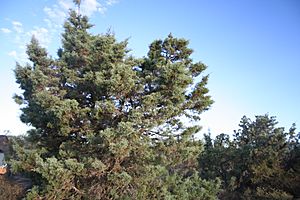Actinostrobus arenarius facts for kids
Quick facts for kids Actinostrobus arenarius |
|
|---|---|
 |
|
| Conservation status | |
| Scientific classification | |
| Genus: |
Actinostrobus
|
| Species: |
arenarius
|
| Synonyms | |
|
|
Actinostrobus arenarius is a type of plant known as a conifer. It belongs to the cypress family, called Cupressaceae. People often call it the sandplain cypress, Bruce cypress, Bruce cypress-pine, or tamin. This plant is special because it grows only in Western Australia.
Contents
About the Sandplain Cypress
This plant can be a shrub (a small bush) or a tree. It can grow up to about 5 meters (16 feet) tall. It has branches that spread out, with smaller twigs.
What Does It Look Like?
The leaves of the sandplain cypress look like scales. They are gray-green and can be up to 1.2 centimeters (about half an inch) long. These leaves grow in groups of three.
The plant has two types of cones:
- Male cones are shaped like cylinders and are about half a centimeter long.
- Female cones are larger, up to 2 centimeters (about 0.8 inches) long. They have pointed scales. Inside these female cones, you'll find seeds with wings.
How It Was Discovered and Named
A botanist named Charles Austin Gardner first described this plant in 1964. He found a sample of it near Tammin, Western Australia. The plant's scientific name, arenarius, comes from the Latin word arena, which means "sand". This name was chosen because the sandplain cypress grows in sandy areas.
In 2010, scientists studied Actinostrobus and another group of plants called Callitris. They found that Actinostrobus plants were very similar to Callitris plants. Because of this, Actinostrobus arenarius was given a new name: Callitris arenaria.
Where Does It Grow?
The sandplain cypress grows in groups in sandy areas called sandplains. It is part of a low, bushy plant community known as kwongan. Other plants that often grow nearby include:
- Banksia, Conospermum, Grevillea, and Hakea (from the Proteaceae family)
- Melaleuca (from the Myrtaceae family)
- Different types of Acacia
- Other conifers like Callitris preissii and C. roei
Some of the places where this plant grows have been changed or damaged by human activity. However, the sandplain cypress is still found in many areas. It also grows in several protected natural parks. You can find it from Lake Grace in the south up to the Murchison River in the north.
The Bruce cypress is good at growing in places that have been disturbed. You might see it forming groups along the sides of roads or in areas that have been cleared for farming.


